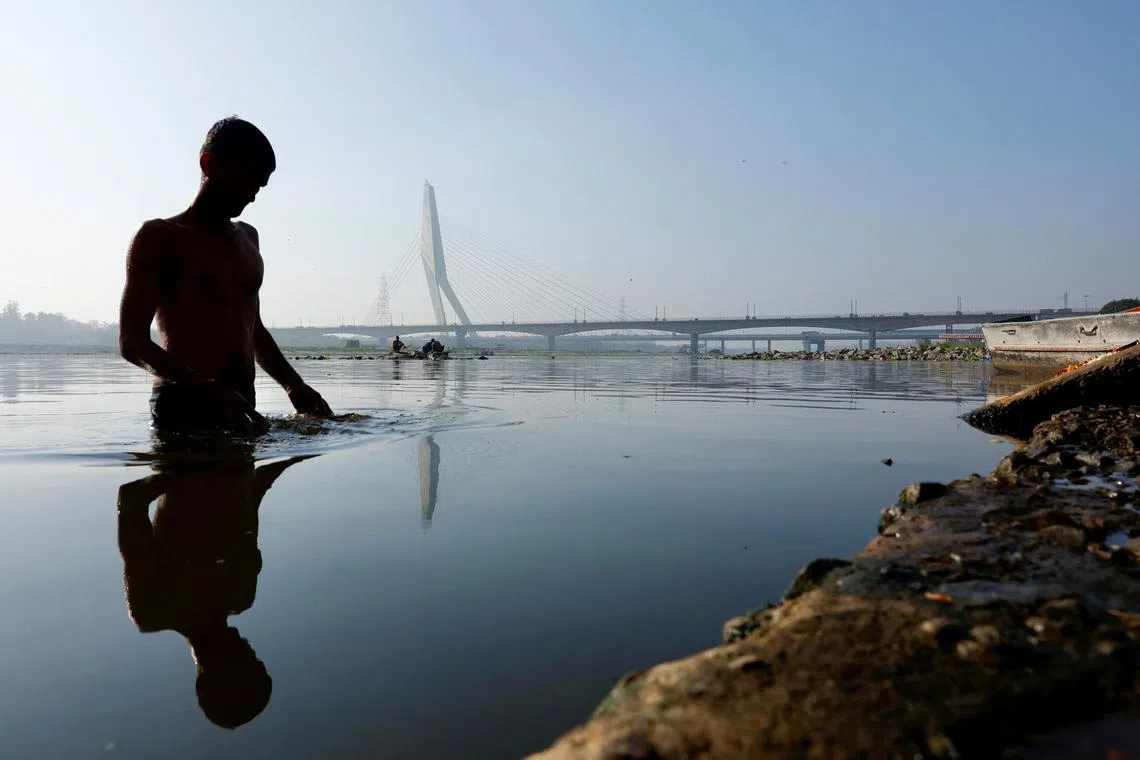Indian cities keen to develop riverfronts but bogged down by polluted rivers
Sign up now: Get ST's newsletters delivered to your inbox

Thousands doing yoga together on the Sabarmati riverfront in Ahmedabad, India, on World Yoga Day, on June 21.
PHOTO: REUTERS
Follow topic:
NEW DELHI – As Indian cities roll out plans to build attractive riverfronts, the improvements on land are outpacing attempts to clean up the waters of the polluted rivers below them.
In the western state of Gujarat, a plan to extend the riverfront from the existing 11.25km in Ahmedabad city along the Sabarmati River to 38km includes the development of a 17.5km stretch by Singapore firm Surbana Jurong.
The urban planning and design specialist is creating the masterplan for the last phases of the development, covering 591ha of land. The first phase was completed in 2012 but other earlier phases are in different stages of development by other companies.
“When completed, it will be the longest riverfront project in the world, with a total length of over 38km,” said Mr Abhishek Malhotra, Surbana Jurong’s regional director for South Asia.
While the riverfront projects have given residents a much-needed public space, a key challenge for Ahmedabad and other cities with riverfront plans, however, is the extremely polluted rivers, which are clogged with sewage, toxic chemicals discharged by factories and rubbish from rapidly growing cities.
Along the 371km-long Sabarmati River, which flows from the north-western state of Rajasthan into Gujarat, multiple cleaning operations have taken place but with limited success, said environmentalists.
In the latest initiative to clean up the river, some 60,000 residents of Ahmedabad have since May 15 picked up 945 tonnes of waste from the riverbed after water was drained to repair the Vasna Barrage, which controls the flow of water into the Sabarmati River near the riverfront.
This is among other initiatives, both short and long term, to clean up the river – from using trash skimmers to collect floating rubbish to tackling the problem of untreated sewage. However, the pollutants going into the river have continued to outpace clean-up efforts, noted environmentalists.
“The cleanliness drive is also to ensure wider awareness so that people don’t throw waste into the river. We want river waters to be clean,” said Ahmedabad municipal commissioner Banchhanidhi Pani.

A boy looking for recyclables on the banks of Yamuna River in New Delhi on April 11.
PHOTO: AFP
But it is not just the discarded rubbish that is the problem.
A report released recently by Toxics Link, an Indian environmental research and advocacy organisation, said high levels of nonylphenol – a chemical with carcinogenic properties that can cause prostate cancer in men and breast cancer in women – were detected in the surface water of four rivers including the Sabarmati, downstream of the riverfront project.
The chemical, which also kills aquatic life, is used in the textile industry in particular. The report found the highest concentration of the chemical in Cooum River in Tamil Nadu.
“It is not enough to keep the riverfront water clean and not the rest of the stretch,” said Mr Mahesh Pandya, director of Paryavaran Mitra, a Gujarat-based non-governmental organisation dedicated to protecting the environment.
In September 2024, the Gujarat High Court rebuked the local authorities for failing to come up with a concrete plan for cleaning up the river. The court initiated public interest litigation on its own and has kept a close scrutiny over the clean-up efforts. “All your claims are on paper,” the court noted, according to a report in the Gujarat Samachar newspaper.
Contamination from untreated sewage is a common problem for India’s rivers.
According to some estimates, 38,000 million litres of wastewater enter Indian rivers due to the lack of functioning sewage treatment plants and poor waste disposal.
Many riverfront projects in the pipeline
Polluted rivers present a jarring challenge to local governments’ plans to spruce up riverfronts and turn them into attractive urban community spaces.
A report by the School of Planning and Architecture (SPA) said 61 riverfront projects have been initiated under the Smart Cities Mission, an urban renewal and retrofitting programme by the government to improve facilities and infrastructure in Indian cities. Many more are being developed outside the mission.
Along the Sabarmati, the first 11.25km of the riverfront development, completed in 2012, has been held up as an exemplary instance of riverfront development in India.
Prime Minister Narendra Modi, who was the chief minister of Gujarat from 2001 to 2014, hosted world leaders like Chinese President Xi Jinping in 2014 and the late former Japanese prime minister Shinzo Abe in 2017 at the riverfront.
Surbana Jurong, which has joined the further development of the riverfront, aims to foster “a vibrant and engaging urban-river interface”, said Mr Malhotra.
He said the masterplan “embraces the natural slope of the riverbanks to create a convenient transition from the street level to the lower terrace, enhancing the connection between riverfront and the surrounding urban fabric”.
The firm would be using a “blend of design strategies – from landscaped stepped terraces to natural, soft edges”, he added, allowing “inclusive public access for people of all abilities”.
The Gujarat government is also proposing to build a Singapore-style Cloud Forest – a greenhouse-like structure with exotic trees and plants under a dome – covering an area of over 2,500 sq m, which is smaller than a football field.
The trend to develop riverfronts in India is part of a larger push to boost urban infrastructure and make cities liveable.
A study on waterfront development projects by the SPA, a public higher education institution, noted that such projects are significant as cities are “grappling with multiple issues of pollution, biodiversity loss and extreme pressure on open spaces”.

While riverfront projects have given residents a public space, a key challenge cities face is the polluted rivers.
PHOTO: REUTERS
It added that these developments lead to “an increase in available and usable open spaces, re-establishing the lost connection between the people and the water body, an increase in livelihood options and property prices”.
The SPA study noted that the development of the Ganga riverfront in the eastern city of Patna in Bihar state had led to significantly enhanced recreational facilities, improved public transport connectivity, and addressed waste management issues.
It further noted that anecdotal evidence suggested a potential increase in property values and economic activity.
In 2022, the Central Pollution Control Board identified 311 polluted river stretches, calculated through levels of biochemical oxygen demand, an important indicator of water quality, on 279 rivers.
Clean up rivers before developing riverfronts
In some cities, residents are putting pressure on the authorities to pay as much attention to environmental concerns as developing the riverfront.
Angry citizens of Pune, a city in the western state of Maharashtra, have staged protest marches, filed lawsuits and planted trees to demand that the Mula River be cleaned up and that riverfront developments take environmental concerns into account.
A concrete-heavy riverside development would affect the natural aqueducts that charge the groundwater and the biodiversity along the river, said Pune-based environmentalist Mukund Mavalankar.
“We have pointed out that the river is dying because of untreated sewage going into the river. This needs to be tackled first,” said Mr Mavalankar.
The capacity of sewage treatment plants along the Mula River is 500 million litres per day, when the required capacity is 1,000 million litres, he added.
While the protests and legal cases have not stalled plans as yet, they have brought focus on the issue of rejuvenating rivers and ensuring that wanton construction does not take place along their banks.
A key problem has also been the lack of a holistic approach to cleaning rivers that flow through multiple states, water experts noted, arguing that piecemeal efforts are often unsuccessful despite the best intentions.
Ms Jaya Dhindaw, the executive programme director of Sustainable Cities at WRI India, an independent research organisation, said important initiatives and institutional mechanisms have been set up by the government, like the National Mission for Clean Ganga to clean the river Ganga and the surrounding areas.
The Ganga is a 2,525km-long river that crosses multiple states in India before flowing into Bangladesh.
But she noted: “There still remains a lot to be done in terms of addressing issues such as checking and stopping source pollution, integrating ecosystem preservation and restoration, and ensuring financial and institutional wherewithal for maintenance of clean-ups.”
She said: “A data-led approach which helps identify the sources of pollution, strong enforcement of pollution control, integrating nature-based solutions to manage water quality, and enabling community ownership and stewardship of rivers are essential to the long-term success of clean-up efforts.”
Test case in Delhi
A test case for whether river rejuvenation can happen with riverfront development is in the capital city.
The Delhi government, which like Gujarat’s is led by Mr Modi’s Bharatiya Janata Party, has promised a Sabarmati-type riverfront makeover along the Yamuna River.
Plans include creating a central piazza, topiary park, shopping centre and river promenade along a 22km stretch of the river.
The Yamuna flows through multiple states, with the stretch in Delhi among its most polluted. Between 2017 and 2022, the Delhi government spent more than 68 billion rupees (S$1 billion) to clean the Yamuna, but it still has high levels of pollutants from untreated sewage and industrial waste.
The Delhi government recently announced a 30-point action plan to clean up the river, which includes building 40 sewage treatment plants.
For residents, a riverfront to go to for a stroll or a cruise down the river is an attractive proposition.
“It would be great to have a riverfront,” said Ms Ritu Sharma, a Delhi resident, who added that she would love to take a walk along the riverfront. “But I hope they can clear the pollution too.”
Nirmala Ganapathy is India bureau chief at The Straits Times. She is based in New Delhi and writes about India’s foreign policy and politics.


